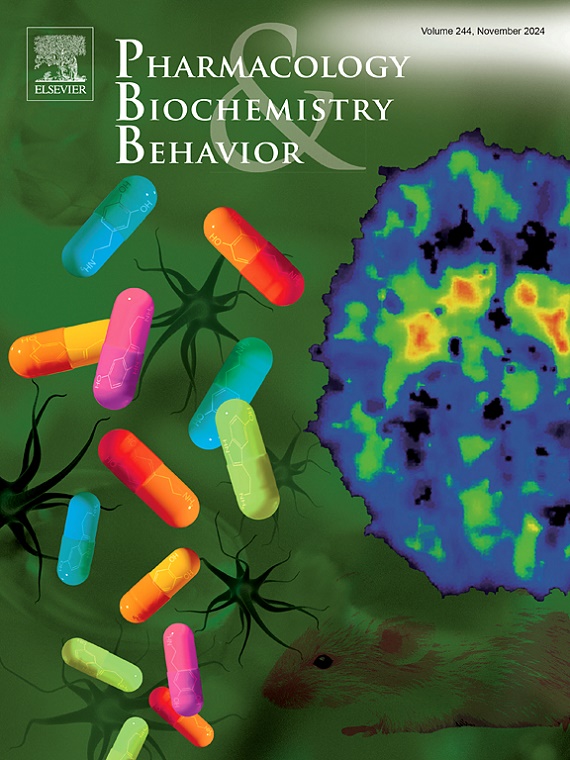西维美林预防氯氮平诱导的雌性大鼠血脂异常的剂量依赖性作用
IF 3.3
3区 心理学
Q1 BEHAVIORAL SCIENCES
引用次数: 0
摘要
氯氮平是最有效的第二代抗精神病药物,尤其适用于治疗难治性精神分裂症。然而,它与代谢副作用有关。氯氮平对毒蕈碱M3受体具有高度的拮抗亲和力,据报道,这在这些副作用中起重要作用。本研究旨在探讨西维美林(一种M3受体激动剂)是否可以预防氯氮平引起的代谢紊乱。雌性Sprague Dawley大鼠口服氯氮平(20 mg/kg,每日3次)和/或西维美林(3、6、9 mg/kg,每日3次),或给药2周。记录体重增加、食物/水摄入量和体温。进行开阔场试验以评估运动活动。仅氯氮平治疗可显著降低体重增加、喂养效率、肾周、骨膜、腹股沟、总白色脂肪量和NEFA水平。氯氮平引起的体重增加和摄食效率的降低可通过与3或6 mg/kg西维美林共同治疗部分逆转。氯氮平还显著增加了肝脏质量、LDL和HDL水平,而在所有测试剂量下,与西维美林共同治疗可以逆转这种情况。这些结果支持进一步的临床试验来评估西维美林在控制氯氮平诱导的血脂异常方面的潜力。本文章由计算机程序翻译,如有差异,请以英文原文为准。
The dosage-dependent effects of cevimeline in preventing clozapine-induced dyslipidaemia in female rats
Clozapine is the most effective second-generation antipsychotic drug, especially for the therapy of treatment-resistant schizophrenia. However, it is associated with metabolic side-effects. Clozapine has a high antagonistic affinity to muscarinic M3 receptors, which has been reported to play a significant role in these side-effects. This study aimed to investigate whether co-administration of cevimeline (an M3 receptor agonist) could prevent the metabolic disorders induced by clozapine. Female Sprague Dawley rats were treated orally with clozapine (20 mg/kg, 3 times daily) and/or cevimeline at three dosages (3, 6, 9 mg/kg, 3 times daily), or a vehicle for two weeks. Body weight gain, food/water intake, and temperature were recorded. Open field tests were performed to assess motor activity. Clozapine only treatment significantly decreased body weight gain, feeding efficiency, perirenal, periovary, inguinal, total white fat mass, and NEFA levels. The reduction in body weight gain and feeding efficiency caused by clozapine was partially reversed by co-treatment with 3 or 6 mg/kg cevimeline. Clozapine also significantly increased the liver mass, LDL, and HDL level, which were reversed by the co-treatment with cevimeline at all tested dosages. These results support further clinical trials to evaluate cevimeline's potential in controlling clozapine-induced dyslipidemia.
求助全文
通过发布文献求助,成功后即可免费获取论文全文。
去求助
来源期刊
CiteScore
6.40
自引率
2.80%
发文量
122
审稿时长
38 days
期刊介绍:
Pharmacology Biochemistry & Behavior publishes original reports in the areas of pharmacology and biochemistry in which the primary emphasis and theoretical context are behavioral. Contributions may involve clinical, preclinical, or basic research. Purely biochemical or toxicology studies will not be published. Papers describing the behavioral effects of novel drugs in models of psychiatric, neurological and cognitive disorders, and central pain must include a positive control unless the paper is on a disease where such a drug is not available yet. Papers focusing on physiological processes (e.g., peripheral pain mechanisms, body temperature regulation, seizure activity) are not accepted as we would like to retain the focus of Pharmacology Biochemistry & Behavior on behavior and its interaction with the biochemistry and neurochemistry of the central nervous system. Papers describing the effects of plant materials are generally not considered, unless the active ingredients are studied, the extraction method is well described, the doses tested are known, and clear and definite experimental evidence on the mechanism of action of the active ingredients is provided.

 求助内容:
求助内容: 应助结果提醒方式:
应助结果提醒方式:


